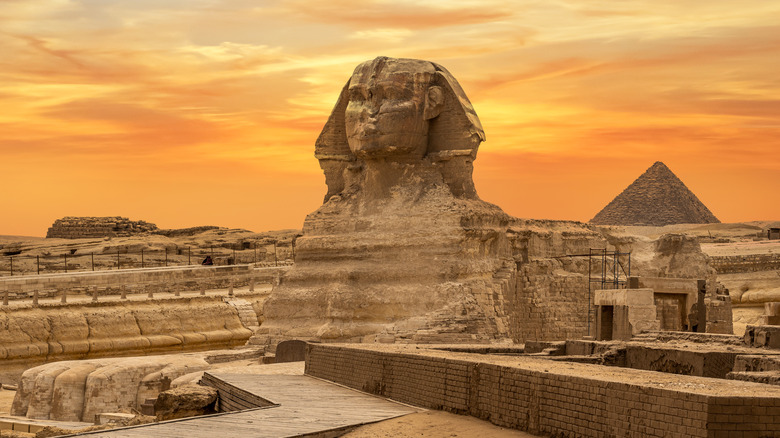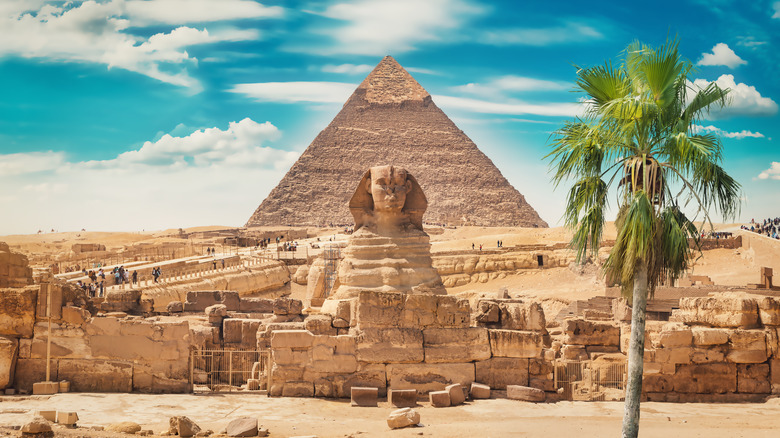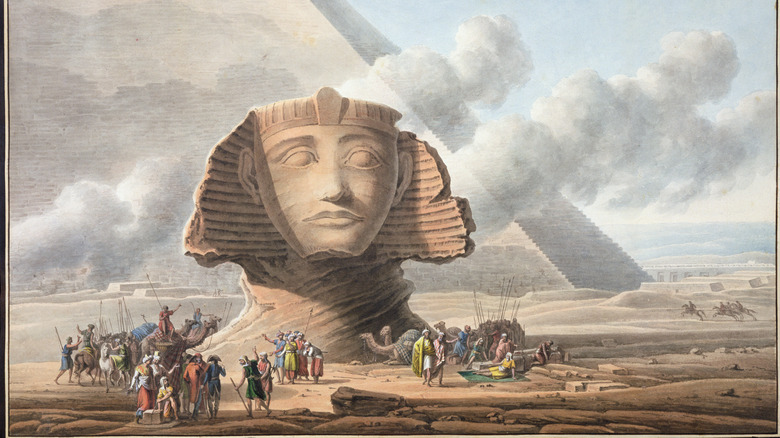Did Napoleon Really Shoot Off The Great Sphinx's Nose?
Many of the world's great historical monuments that have survived the ages are in various states of disrepair, some worse off than others. For example, many ancient Roman structures, some, such as the Pantheon, in pretty good shape, while others, such as what remains of the forum, are little more than ruins.
Egypt is home to a collection of ancient monuments centuries older than the Roman ones, and which are still (mostly) in their original form. Giza, Egypt is the site of three major pyramids and several smaller ones, all of which are showing signs of age but nevertheless remain standing.
Also at Giza is the famed Sphinx, a single block of sandstone carved into the likeness of a cat with a human face, as Britannica describes it. Though in remarkably good shape for a structure that's five millennia old, it does have one major and visible flaw: Its nose is gone. What's more, for centuries rumor has held that Napoleon's men accidentally shot off its nose during battle.
The history of the sphinx
There are several sphinxes across Egypt, according to History. After all, the mythological creature was a part of the region's folklore at the time, in both Egyptian mythology as well as Greek and West Asian folklore. The being with the body of a lion and head of a man (or woman) was believed to be a spiritual guardian and protector. As such, there's a two-mile stretch of Ancient Egypt that has been given the nickname "Sphinx Alley."
THE Sphinx, however, is at Giza. History is not clear on when or why it was built, but the evidence seems to suggest that the 66-foot-tall, 250-foot-long monument was built for the Pharaoh Khafre in about 2603-2578 B.C. Archaeologists have found flecks of what they believe is red paint, suggesting that the monument may have at one time been painted.
These days, the Sphinx is a major tourist attraction, and the Egyptian government is keen to keep it accessible. However, as recently as the early 1800s, the entire thing was buried in sand, and it took until the 1930s to dig it out.
Napoleon's men didn't shoot its nose off
Despite the historical legend that Napoleon Bonaparte's men shot off the Sphinx's nose with a cannon when they rolled through the region in 1798, we know for certain that the French military leader wasn't responsible, according to Egypt Today. We know this because a painting from 1737 — a half a century before Napoleon and his men came calling — shows the stone beast without its nose.
What is believed to have happened, according to Mental Floss, is that a religious zealot and devout Muslim named Muhammad Sa'im al-Dahr was put off by the practice of area peasants making sacrifices to the Sphinx in order to prevent floods. Believing this to be an unacceptable act of idolatry, al-Dahr is said to have deliberately chopped off its nose with a hammer and chisel some time in the 14th century. In the book "The Complete Pyramids," evidence in the very rock itself revealed that someone had penetrated the area under the nose with a hammer and chisel, and used those tools to pry it off. However, the archaeologist who did that research concluded that the nose was likely broken off between the 3rd and 10th centuries — hundreds of years earlier than al-Dahr's alleged vandalism.


